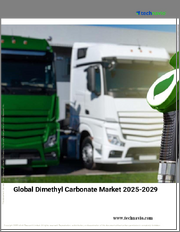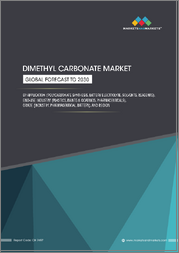
|
시장보고서
상품코드
1616776
디메틸카보네이트 시장 기회, 성장 촉진요인, 산업 동향 분석, 예측(2024-2032년)Dimethyl Carbonate Market Opportunity, Growth Drivers, Industry Trend Analysis, and Forecast 2024 - 2032 |
||||||
디메틸카보네이트 세계 시장은 2023년 11억 달러로 평가되며 2024-2032년 연평균 8.2%의 성장률을 보일 것으로 예상됩니다.
이러한 성장 궤도의 주요 요인은 다양한 산업, 특히 폴리카보네이트 플라스틱 제조에서 친환경 대체 화학제품에 대한 수요가 급증하고 있기 때문입니다. 자동차, 전자, 건축 등의 분야에서 고성능 플라스틱, 특히 폴리카보네이트에 대한 수요가 증가함에 따라 시장은 큰 폭의 성장을 이룰 것으로 예상됩니다. 디메틸카보네이트는 기존 용제나 시약에 비해 환경에 미치는 영향이 적은 것으로 평가받고 있으며, 특히 산업계가 지속가능한 재료와 공정으로 전환하는 과정에서 이들 부문에서 매우 중요한 성분으로 부상하고 있습니다. 디메틸카보네이트는 독성이 낮고 배터리 성능과 안전성을 향상시킬 수 있어 배터리 제조에 대한 채택이 증가할 것으로 예상됩니다.
또한, 순환 경제의 중요성과 바이오 기반 디메틸카보네이트의 출현과 같은 추세는 세계 지속가능성 목표와 친환경 제품에 대한 소비자의 선호도 증가와 맞물려 시장에 영향을 미칠 것으로 예상됩니다. 또한, 허가 및 라이선스 동향도 시장 수요를 촉진하는 요인으로 작용하고 있습니다. 디메틸카보네이트 산업은 용도 및 지역별로 구분되며, 2032년까지 12억 달러가 넘을 것으로 예상되는 폴리카보네이트 용도 부문은 큰 모멘텀을 얻을 것으로 예상됩니다.
폴리카보네이트 생산에 필수적인 원료인 디메틸카보네이트는 고성능 플라스틱 생산에 중요한 역할을 합니다. 이러한 플라스틱은 자동차 부품, 전자제품, 건축자재 등에 응용되고 있습니다. 이러한 분야에서 가볍고 내구성이 뛰어나며 충격에 강한 소재에 대한 수요가 급증하면서 이 부문의 성장을 견인하고 있습니다. 또한, 탄소발자국을 최소화하려는 산업계의 노력으로 인해 디메틸카보네이트는 폴리카보네이트 생산에서 포스겐을 대체할 수 있는 대안으로 주목받고 있습니다.
| 시장 범위 | |
|---|---|
| 시작 연도 | 2023년 |
| 예측 연도 | 2024-2032 |
| 시작 가격 | 11억 달러 |
| 예상 가격 | 22억 달러 |
| CAGR | 8.2% |
2032년까지 아시아태평양의 디메틸카보네이트 시장은 800 킬로톤 이상의 수요가 예상됩니다. 아시아태평양에서 디메틸카보네이트(DMC)의 수요가 꾸준히 증가하고 있으며, 다양한 산업적 용도에 힘입어 성장세를 보이고 있습니다. DMC는 리튬이온 배터리의 전해액에 필수적인 성분으로, 전기자동차(EV) 생산 붐과 가전제품 분야의 성장에 따라 DMC의 수요가 증가하고 있습니다. 또한, 환경 지속가능성에 대한 관심이 높아지면서 친환경 화학제품으로의 전환이 가속화되고 있는 것도 친환경적이고 적응력이 높은 DMC의 수요를 증가시키고 있습니다.
목차
제1장 조사 방법과 조사 범위
제2장 주요 요약
제3장 산업 인사이트
- 생태계 분석
- 주요 제조업체
- 유통업체
- 산업 전체의 이익률
- 산업에 대한 영향요인
- 성장 촉진요인
- 시장 과제
- 시장 기회
- 새로운 기회
- 성장 가능성 분석
- 원료 상황
- 제조 동향
- 기술의 진화
- 지속가능한 제조
- 그린 프랙티스
- 탈탄소화
- 지속가능한 제조
- 원료의 지속가능성
- 가격 동향(지역별)(달러/톤)
- 규제와 시장에 대한 영향
- Porters 분석
- PESTEL 분석
제4장 경쟁 구도
- 기업 점유율 분석
- 기업 포지셔닝 매트릭스
- 전략 전망 매트릭스
제5장 시장 규모와 예측 : 용도별, 2021-2032년
- 주요 동향
- 폴리카보네이트
- 용제
- 의약품
- 살충제
- 기타
제6장 시장 규모와 예측 : 제품별, 2021-2032년
- 주요 동향
- 산업용 등급
- 의약품 등급
- 일렉트로닉스 등급
제7장 시장 규모와 예측 : 지역별 시장 규모와 예측 : 지역별, 2021-2032년
- 주요 동향
- 북미
- 미국
- 캐나다
- 유럽
- 독일
- 영국
- 프랑스
- 이탈리아
- 스페인
- 기타 유럽
- 아시아태평양
- 중국
- 인도
- 일본
- 한국
- 호주
- 기타 아시아태평양
- 라틴아메리카
- 브라질
- 멕시코
- 아르헨티나
- 기타 라틴아메리카
- 중동 및 아프리카
- 사우디아라비아
- 아랍에미리트
- 남아프리카공화국
- 기타 중동 및 아프리카
제8장 기업 개요
- Merck KGaA
- UBE Industries
- Kishida Chemicals
- Tangshan Chaoyang Chemical
- Connect Chemicals
- Dongying City Longxing
- SMC Global
- Alfa Aesar
- Asahi Kasei Corporation
- Kowa American Corporation
The Global Dimethyl Carbonate Market was valued at USD 1.1 billion in 2023 and is projected to expand at a CAGR of 8.2% from 2024 to 2032. This growth trajectory is primarily fueled by the surging demand for eco-friendly chemical alternatives across diverse industries, notably in the manufacturing of polycarbonate plastics. With rising demand for high-performance plastics, particularly polycarbonate, in sectors like automotive, electronics, and construction, the market is set for substantial growth. Dimethyl carbonate, recognized for its reduced environmental impacts compared to conventional solvents and reagents, has emerged as a pivotal ingredient in these sectors, especially amidst the industry's shift towards sustainable materials and processes. Given its less toxic nature and ability to boost battery performance and safety, dimethyl carbonate is poised to see increased adoption in battery manufacturing.
Furthermore, trends, such as the emphasis on circular economy practices and the emergence of bio-based dimethyl carbonate are expected to influence the market, resonating with global sustainability objectives and the rising consumer preference for eco-friendly products. The market demand is also bolstered by increasing approvals and licensing trends. The dimethyl carbonate industry is divided based on application and region. Forecasted to surpass USD 1.2 billion by 2032, the polycarbonate application segment is set to gain substantial momentum.
As a vital raw material for polycarbonate production, dimethyl carbonate plays a crucial role in creating high-performance plastics. These plastics find applications in automotive components, electronics, and construction materials. The surging demand for lightweight, durable, and impact-resistant materials in these sectors propels segment growth. Moreover, the industry's push to minimize carbon footprints in manufacturing has spotlighted dimethyl carbonate as a greener substitute for phosgene in polycarbonate production.
| Market Scope | |
|---|---|
| Start Year | 2023 |
| Forecast Year | 2024-2032 |
| Start Value | $1.1 Billion |
| Forecast Value | $2.2 Billion |
| CAGR | 8.2% |
By 2032, the Asia Pacific dimethyl carbonate market is anticipated to demand over 800 kilotons. The APAC region is witnessing a robust surge in dimethyl carbonate (DMC) demand, spurred by its diverse industrial applications. As an essential ingredient in lithium-ion battery electrolytes, DMC's demand is escalating, paralleling the boom in electric vehicle (EV) production and the expanding consumer electronics sector. Countries like China and India, undergoing rapid industrialization and urbanization, are amplifying their DMC needs, especially in automotive and electronics.Furthermore, a heightened emphasis on environmental sustainability and a transition towards green chemicals underscores the demand for DMC, celebrated for its eco-friendly attributes and adaptability.
Table of Contents
Chapter 1 Methodology & Scope
- 1.1 Market scope & definition
- 1.2 Base estimates & calculations
- 1.3 Forecast calculation
- 1.4 Data sources
- 1.4.1 Primary
- 1.4.2 Secondary
- 1.4.2.1 Paid sources
- 1.4.2.2 Public sources
Chapter 2 Executive Summary
- 2.1 Industry 360° synopsis
Chapter 3 Industry Insights
- 3.1 Industry ecosystem analysis
- 3.1.1 Key manufacturers
- 3.1.2 Distributors
- 3.1.3 Profit margins across the industry
- 3.2 Industry impact forces
- 3.2.1 Growth drivers
- 3.2.2 Market challenges
- 3.2.3 Market opportunity
- 3.2.3.1 New opportunities
- 3.2.3.2 Growth potential analysis
- 3.3 Raw material landscape
- 3.3.1 Manufacturing trends
- 3.3.2 Technology evolution
- 3.3.2.1 Sustainable manufacturing
- 3.3.2.1.1 Green practices
- 3.3.2.1.2 Decarbonization
- 3.3.2.1 Sustainable manufacturing
- 3.3.3 Sustainability in raw materials
- 3.3.4 Pricing trend, by Region (USD/Ton)
- 3.3.4.1 North America
- 3.3.4.2 Europe
- 3.3.4.3 Asia Pacific
- 3.3.4.4 Latin America
- 3.3.4.5 Middle East & Africa
- 3.4 Regulations & market impact
- 3.5 Porter's analysis
- 3.6 PESTEL analysis
Chapter 4 Competitive Landscape, 2023
- 4.1 Company market share analysis
- 4.2 Company positioning matrix
- 4.3 Strategy outlook matrix
Chapter 5 Market Size and Forecast, By Application, 2021-2032 (USD Million, Kilo Tons)
- 5.1 Key trends
- 5.2 Polycarbonate
- 5.3 Solvent
- 5.4 Pharmaceutical
- 5.5 Pesticide
- 5.6 Others
Chapter 6 Market Size and Forecast, By Product, 2021-2032 (USD Million, Kilo Tons)
- 6.1 Key trends
- 6.2 Industrial grade
- 6.3 Pharmaceutical grade
- 6.4 Electronic grade
Chapter 7 Market Size and Forecast, By Region, 2021-2032 (USD Million, Kilo Tons)
- 7.1 Key trends
- 7.2 North America
- 7.2.1 U.S.
- 7.2.2 Canada
- 7.3 Europe
- 7.3.1 Germany
- 7.3.2 UK
- 7.3.3 France
- 7.3.4 Italy
- 7.3.5 Spain
- 7.3.6 Rest of Europe
- 7.4 Asia Pacific
- 7.4.1 China
- 7.4.2 India
- 7.4.3 Japan
- 7.4.4 South Korea
- 7.4.5 Australia
- 7.4.6 Rest of Asia Pacific
- 7.5 Latin America
- 7.5.1 Brazil
- 7.5.2 Mexico
- 7.5.3 Argentina
- 7.5.4 Rest of Latin America
- 7.6 MEA
- 7.6.1 Saudi Arabia
- 7.6.2 UAE
- 7.6.3 South Africa
- 7.6.4 Rest of MEA
Chapter 8 Company Profiles
- 8.1 Merck KGaA
- 8.2 UBE Industries
- 8.3 Kishida Chemicals
- 8.4 Tangshan Chaoyang Chemical
- 8.5 Connect Chemicals
- 8.6 Dongying City Longxing
- 8.7 SMC Global
- 8.8 Alfa Aesar
- 8.9 Asahi Kasei Corporation
- 8.10 Kowa American Corporation



















